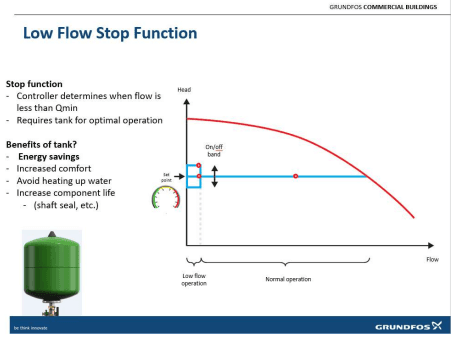Low-Flow Shutdown Sequence for Pressure-Boosting Systems
According to ASHRAE 90.1, Domestic Water Booster Systems must shut down during periods of no flow demand. Operating pump systems when there is little or no demand wastes energy and increases wear and tear on the pump and piping system. While this sounds simple, it is one of the most challenging control sequences for a Booster System.
Domestic Water Booster Systems are used to supply water to commercial buildings to be used in restrooms, kitchens, and to make up water to Hydronic Systems like Cooling Towers. The demand for water will change throughout the day and the pump system must be able to respond to these changes. In commercial office buildings, for example, there can be long periods of little or no water demand overnight when the building is empty or even in the middle of the afternoon when the building is occupied.
For a pump system to perform a low-flow shutdown, it must first be able to measure the flow demands in the system. Flow Switches and Flow Meters are mechanical means of measuring flow, which can work, but both require proper installation in the system piping for proper readings. Space and piping constraints can limit the installation of switches or flow meters.
System Controllers like the Grundfos CU352 on the BoosterpaQ can calculate system flow using feedback from the pump Variable Frequency Drives (VFDs) and pressure readings from the system headers, eliminating the need for additional flow sensors. Once the CU352 detects low flow, it will start the Low Flow Shutdown Sequence by ramping the pressure up above the set point for a preset period. This ensures the entire piping and bladder tank are pressurized before the pump package shuts down.
Hydro-pneumatic or bladder tanks are used in the piping system either at the pump discharge or off the main riser on the upper floors of a building. With a proper air charge (typically 5 to 7 PSI below system pressure at the tank), the bladder tank will maintain the system water pressure while the pumps are off during low flow. Water from the bladder tank can handle a small water demand such as a toilet flushing or a sink being used. Once the water from the bladder tank is used and the system pressure drops, the pump system will turn on briefly to re-pressurize the system and the bladder tank, then shut down again. This process will repeat until normal flow demands resume in the building and the CU352 Controller will operate the pumps normally.
A bad or improperly charged bladder tank and poor controls cause pumps to short cycle during low-flow demands. Pumps will turn off, only to have the system pressure drop immediately, causing the pumps to turn back on. Short cycling pumps in this manner will increase wear and tear on the pumps, motors and piping components, leading to early mechanical failures.
A pump system with a good low-flow shutdown sequence and properly sized bladder tank will provide constant water pressure with reduced energy savings and system wear. As part of a Building Assessment, Cougar USA reviews existing pump systems for low-flow shutdown controls and properly installed bladder tanks.
When you subscribe to the blog, we will send you an e-mail when there are new updates on the site so you wouldn't miss them.


